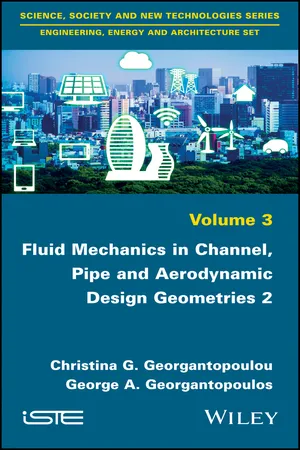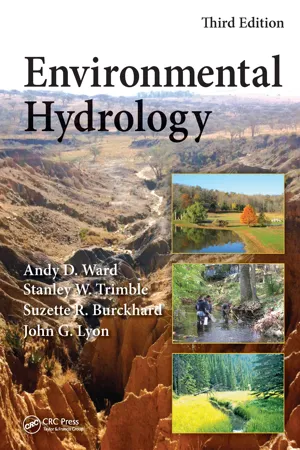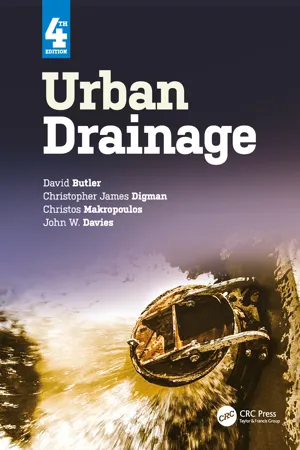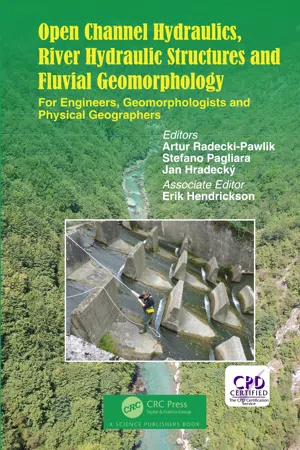Technology & Engineering
Open Channel Flow
Open channel flow refers to the movement of fluid in a conduit with a free surface, such as rivers, canals, and streams. It is characterized by the presence of air above the fluid and is governed by principles of fluid mechanics and hydraulics. Engineers and scientists study open channel flow to understand and manage water resources, design hydraulic structures, and mitigate flood risks.
Written by Perlego with AI-assistance
Related key terms
Related key terms
1 of 4
Related key terms
1 of 3
5 Key excerpts on "Open Channel Flow"
- Christina G. Georgantopoulou, George A. Georgantopoulos(Authors)
- 2018(Publication Date)
- Wiley-ISTE(Publisher)
2 Open Channel Flow2.1. IntroductionA channel transferring a fluid is called the Open Channel Flow or channel of free flow or canal when the fluid that flows inside its free surface is below the atmospheric pressure. Forces that create the flow are influenced by the gravity and the inclination of the channel.The air resistance and the forces of the surface stresses on the fluid’s free surface are considered to be negligible. Forces that slow down the flow are caused by the viscous shear stress of the fluid, and frictions are created by its contact with channel walls.The open channels are distinguished into two categories, namely natural channels and artificial channels. The first category includes naturally existing channels, such as rivers, streams and various natural currents, while the second category includes artificially created canals and ditches for irrigation, drainage and other purposes, which vary in size, shape and surface roughness. Because of their construction process, artificial channels have known geometry and different roughness values. They are also called prismatic, when the cross-sectional area and the inclination of their bottom are constant. According to the geometrical shape of their cross-sectional area, the prismatic channels are:- i) rectangular;
- ii) trapezoidal;
- iii) triangular;
- iv) semi-circular;
- v) parabolic.
2.2. Non-dimensional parameters in open channelsThe flow of a fluid in open channels is influenced by gravity, cohesion and friction forces on the channel walls. The forces of compression and pressure are negligible. The non-dimensional parameters that express these forces are: a) the Froude number Fr and b) the Reynolds number.i) The Froude number expresses inertia forces and gravity forces and is given by the relation:[2.1]where V is the average flow velocity, g is the acceleration due to gravity and h is the depth of the flow.As the Froude number is non-dimensional, the denominator- eBook - ePub
- Andy D. Ward, Stanley W. Trimble, Suzette R. Burckhard, John G. Lyon(Authors)
- 2015(Publication Date)
- CRC Press(Publisher)
7 Uniform Open Channel Flow7.1 INTRODUCTION
Flow in a stream or constructed channel is a function of many factors, including precipitation, overland flow, interflow, groundwater flow, and pumped inflows and outflows; the cross-sectional geometry and bed slope of the channel, the bed and side slope roughness; meandering, obstructions, and changes in shape; hydraulic control structures and impoundments; and sediment transport. Generally, flow in ditches, channels, streams, and large rivers is classified as Open Channel Flow because the water surface is open to the atmosphere. Open Channel Flow can occur in many ways. For example, it can be turbulent in steep, rocky areas or following severe storm events. Also, during severe storm events, there might be rapid changes in the depth and amount of flow. On other occasions, it can be tranquil, and it will be difficult to detect that the water is flowing. Flow may be classified into many types (Figure 7.1 ), and a different mathematical equation is needed to describe each type. Flow in an open channel is steady if the flow depth does not change or is considered constant during the time interval under consideration. The flow is uniform if the flow depth is similar along a reach of the channel. Steady uniform Open Channel Flow is often called the normal flow. In a natural channel, these conditions might only occur along reaches that are a few channel widths long or might never occur in some mountain streams. As we move from one feature, such as a riffle, to another feature, such as a pool, we need to redefine the cross section and perhaps switch calculation methods as the flow type changes. We see in Figure 7.1 that different types of flow are classified as subcritical, critical, or supercritical. We will learn in this chapter how to quantify and then apply knowledge of steady uniform flow. In Chapter 8 - eBook - ePub
- David Butler, Christopher James Digman, Christos Makropoulos, John W. Davies(Authors)
- 2018(Publication Date)
- CRC Press(Publisher)
Chapter 7 Hydraulics 7.1IntroductionAn understanding of hydraulics is needed in the design of new drainage systems in order to specify the appropriate size of system components, especially pipes, channels, and tanks. It is also needed in the analysis and modelling of existing systems in order to predict the relationship between flow rate and depth for varying inflows and conditions.Study of civil engineering hydraulics tends to concentrate on two main types of flow. The first is pipe flow in which a liquid flows in a pipe under pressure. The liquid always fills the whole cross section, and the pipe may be horizontal, or inclined up or down in the direction of flow. The second is open-channel flow , in which a liquid flows in a channel by gravity, with a free surface at atmospheric pressure. The liquid only fills the channel when the flow rate equals or exceeds the designed capacity, and the bed of the channel slopes down in the direction of flow.The most common type of flow in sewer systems is a hybrid of these two: part-full pipe flow , in which a liquid flows in a pipe by gravity, with a free surface. The liquid only fills the pipe area when the flow rate equals or exceeds the designed capacity, and the bed of the pipe slopes down in the direction of flow. Traditionally the theories used are most closely related to those for full pipes, though part-full pipe flow is actually a special case of open-channel flow.In this chapter we deal with the types of flow in the following order: pipe flow (Section 7.3 ), part-full pipe flow (7.4 ), and open-channel flow (7.5 ). Aspects of hydraulics are developed where appropriate in other chapters, for example, those relating to special features in Chapter 8 ; to the design of sewers in Chapters 9 , 10 , and 12 ; storage in Chapter 13 ; pumped systems in Chapter 14 ; and flow models in Chapter 19 .This chapter presents the main principles of hydraulics relevant to urban drainage (Section 7.2 - eBook - ePub
Open Channel Hydraulics, River Hydraulic Structures and Fluvial Geomorphology
For Engineers, Geomorphologists and Physical Geographers
- Artur Radecki-Pawlik, Stefano Pagliara, Jan Hradecky, Artur Radecki-Pawlik, Stefano Pagliara, Jan Hradecky(Authors)
- 2017(Publication Date)
- CRC Press(Publisher)
Chapter 1Principles of Hydraulics of Open Channels
Stefano Pagliara and Michele PalermoDESTEC – Department of Energy, Engineering, Systems, Land and Construction, University of Pisa, Via Gabba 22, 56122, Pisa, Italy.E-mail: [email protected] * Corresponding author: [email protected]Introduction
Open Channel Flow can be classified according to the characteristics of the channel. Namely, Open Channel Flow can occur both in natural streams and rivers and in artificial channels, such as drainage channel systems, sewer pipes, concrete/earth channels, etc. According to the geometry of the channel, the water discharge can flow either in prismatic channels (generally characterized by a constant transversal cross‐section geometry and longitudinal slope) or in non‐prismatic channels (natural streams or rivers, in which both the transversal cross‐section geometry and longitudinal bed slope vary). Furthermore, channel bed characteristics also contribute to distinguish the Open Channel Flows, due to the roughness conditions and erosive process, which can contribute to the modification of the channel geometry. In other words, the channel bed can be smooth, rough, erodible, fixed, etc. Therefore, the flow characteristics modify accordingly. In general, two main distinctions can be done according to the flow characteristics variation with time and along the channel (Chow 1959; Citrini and Noseda 1987; De Marchi 1986; Henderson 1966). Considering the flow characteristics along the channel, uniform flow conditions (UF) occur when the discharge Q , the water depth y and the average flow velocity u at every cross‐section do not vary. Namely, at the generic cross‐ section (located at the longitudinal distance x respect to a selected reference system), the following conditions should be verified:(1)=∂ y∂ x=∂ Q∂ x= 0∂ u∂ xThese analytical conditions occur only when the cross‐section geometry do not vary. Therefore, if the water depth is constant, from (Eq. 1 ) it can be easily deduced that the free surface should be parallel to the channel bed (see Fig. 1 - eBook - ePub
A New Approach to Sediment Transport in the Design and Operation of Irrigation Canals
UNESCO-IHE Lecture Note Series
- Herman Depeweg, Néstor Méndez V(Authors)
- 2007(Publication Date)
- CRC Press(Publisher)
CHAPTER 2Open Channel Flow2.1 INTRODUCTION
Irrigation canals form a complicated hydraulic system as they have to handle the motion of water and sediment as well as the mutual interaction of both motions. Flowing water transports sediment, this sediment causes changes in the bed and on the sides of the canal, which also influences the water movement. Hence, sediment transport and water flow are interrelated and cannot be separated; they influence each other in an implicit manner. The time scales of the two processes in canals are different (see Chapter 4 ) and therefore, the water flow and sediment transport can, in the first instance, be treated separately to specify their specific properties and characteristics.However, to predict the topological changes in a canal the two phenomena also have to be considered in conjunction. The objective of these lecture notes is to present a description of the sediment transport concepts in irrigation canals and, therefore, only those hydraulic aspects that are necessary for a better understanding of the sediment transport will be discussed. This chapter will present a short overview of the main hydraulic principles in Open Channel Flow, a short description of the dimensionless numbers used in the sediment concepts and a classification of flow types. In addition, a summary of the uniform and non-uniform theories for steady and unsteady flows is included. For more information on the hydraulic theories, reference will be made to handbooks and lecture notes on hydraulics.2.2 FLOW TYPES AND CHARACTERISTICS
Phenomena in open channels that convey water may vary considerably in magnitude and also sometimes in direction, both in terms of time and space. This chapter will introduce some main aspects of open channel hydraulics in order to be used as tools in the following chapters, which will deal with the movement of sediments and water together. In some cases the water flow in canals varies over time and becomes unsteady. For some applications the variation may be considered to be so slow that a steady (or quasi steady) flow can be assumed. Considering the spatial distribution, any flow is essentially three-dimensional, meaning that the magnitude and direction of the flow vary from one point to another. Knowledge of this three-dimensional flow behaviour is still limited; but in many engineering applications it is often sufficient to know particular mean or average values.
Index pages curate the most relevant extracts from our library of academic textbooks. They’ve been created using an in-house natural language model (NLM), each adding context and meaning to key research topics.
Explore more topic indexes
Explore more topic indexes
1 of 6
Explore more topic indexes
1 of 4




